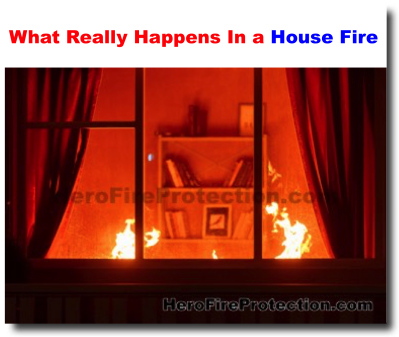What Really Happens In a House Fire
- Tweet

A fire can occur anytime, and you may only have as little as two minutes to escape once it starts. Here’s what can happen during a house fire that starts in the kitchen.
Small flame in the first 30 seconds - A fire can easily spread within seconds of a flare up. If there is spattered grease or oil residue on a dirty stovetop, it can ignite and cause flames to travel across the stove. Other combustible materials like paper towels or dry dish towels nearby can also ignite and burn. Smoke then rises off the flames with the heated air.
If you can, extinguish the fire now. Do not attempt to move any pots or pans as you can burn yourself and spread the fire. Never throw water on a cooking fire as this will just spread the flames. Instead, cover the pan with a lid to put out the flames.
The next 1 minute – As the fire grows higher and hotter, more flammable objects beyond the stovetop will ignite. A denser plume of hot air and smoke rises and spreads across the ceiling.
If you're still in the room, get out now. This fire can burn the insides of your breathing passages and generate highly poisonous gases from coming into contact with insulation, carpets or plastics that are burning. Just two or three breaths of this can cause you to pass out.
The next two minutes - As the flames intensify, the smoke and hot can be reach more than 190 degrees F. Heat from the fire can radiate to other parts of the kitchen, heating up tables, chairs, cookbooks and other objects. The hot cloud of smoke thickens and deepens below the ceiling.
At this stage, cyanide and carbon monoxide levels will also increase steadily. Carbon monoxide poisoning causes more fire related deaths than any other toxic product of combustion.
Two to three minutes – As the fire consumes more of the kitchen space and objects in it, even more heat is generated. The temperature in the upper layer of hot gases rises to 400 degrees F—hot enough to kill. Making things worse is a dense smoke cloud that may be hovering just a few feet above the floor.
The fire can now spread by two paths: direct flame contact or by auto-ignition, the temperature at which objects will spontaneously burst into flames without being touched by flames.
Flashover in 3 1/2 minutes – Flashover occurs when heat from a room fire reaches 1100 degrees F. Everything in the room bursts into flames and oxygen in the room is virtually sucked out. Glass windows will shatter and flames can shoot out windows and doorways. All of the other rooms in the house are now at risk of catching fire.
The next 4 minutes - Flames can pour through the doorway into the neighboring room. Synthetic materials like polyurethane and polyester foam in sofas, pillows or carpets can release high levels of heat Back in the kitchen, the blaze has penetrated the wall and ceiling and flames travel quickly through unseen structural vertical shafts in interior walls and horizontal shafts between floors. Fire can also spread to the second floor at this time.
The next 4 - 5 minutes and when firefighters arrive- Flames can be visible from the street. The type of construction materials used in your home will influence the severity of damage. Synthetics like polyurethane, polystyrene, and PVC used in glues, insulation, and plumbing will auto-ignite at temps between 850 and 1075 degrees. At 1000 degrees F, steel plates used in engineered roof trusses will start to buckle and they lose 40 percent of their load-carrying capacity. Newer homes built with engineered wood can experience floor collapse in as little as 6 minutes. Roof collapse can follow very soon after if the blaze is out of control.
If flames are visible from the outside when firefighters arrive, they will immediately go into an aggressive strategy to determine if they can still save lives safely. They will direct water to extinguish the blaze at the heart of the fire. Water simultaneously cools the burning debris and can limit oxygen's ability to fuel the fire. Firefighters may also vent off hot smoke and gases either by breaking open upstairs windows or cutting a hole in the roof. They may also use dry chemicals to retard spread of fire and extinguish flames.
After the fire - Extensive property damage extends to the entire house. Even in rooms untouched by flames, high heat will have softened glass, blistered wooden floors or melted plastics. Also, many of the burned or melted plastics and synthetic materials will continue to off-gas toxins. It is unsafe for anyone to enter the structure. Likewise, unseen weaknesses in the structure may still cause collapse, you will need to obtain permission from the Fire Marshall to reenter your home.
To help prevent a major fire scenario like this, have your home evaluated for fire safety. Contact Hero Fire Protection today. We are a full-service fire protection company in Hawaii dedicated in educating families about the devastating effects of home fires and other home safety issues. Contact us today to get a FREE fire safety assessment and receive a FREE emergency kit.
ref no:34192
Please send questions about this website to webmaster
Copyright© 2019 - 2023 HeroFireProtection.com. All rights reserved.
Terms of Use / Legal Disclaimer / Privacy Statement
Site Designed and Managed by MacBusiness Consulting
Terms of Use / Legal Disclaimer / Privacy Statement
Site Designed and Managed by MacBusiness Consulting
